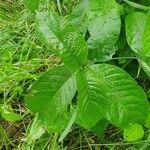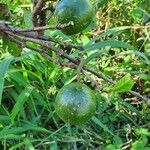Shrub or small tree, 1.5–15 m. tall, often multi-stemmed and sometimes with a spreading crown; stems glabrous, longitudinally ridged, with pale to dark bark, mostly smooth and unpeeling but peeling or powdery in one variant.. Leaf-blades narrowly to broadly elliptic or elliptic-lanceolate, 8–28 cm. long, 3.2–15 cm. wide, acute to shortly acuminate at the apex, cuneate to rounded or less often ± subcordate at the base, entirely glabrous or sometimes very young leaves pilose beneath and adult ones sparsely pubescent; petiole 0.8–1.8 cm. long; stipules with broad base 3–5 mm. long, and narrow apex 0.4–1.8 cm. long, glabrous or pubescent.. Inflorescence pubescent; branches 1–4.5 cm. long, 7–10-flowered; main peduncles ± 1 cm. long; pedicels ± 2 mm. long, save those of central flower of inflorescence which measure 4 mm.. Calyx-tube 1.2–3 mm. long; lobes triangular-oblong to narrowly oblong, 0.5–1.5 mm. long, ± pubescent.. Corolla greenish yellow, yellow or cream, glabrous or rarely with few hairs; tube 3–4.5 mm. long; lobes 3.5–4.5 mm. long, with appendages up to 0.5 mm. long; buds slightly to usually markedly acuminate or apiculate due to the corolla lobe-appendages.. Style 7–8 mm. long; stigmatic club cylindrical, yellow, 1.2–1.5 mm. long.. Fruits green to brownish, subglobose, 2.5–5 cm. in diameter, with 4–5 pyrenes, each ± 2 cm. long, 1.2 cm. wide, 8 mm. thick, with thick woody walls 1–2 mm. thick.. Seeds ±1.6 cm. long, 6 mm. wide, 4.5 mm. thick, narrowed at one end.. Figs. 131/22, p. 752; 132/15, p. 754 & 150.
Shrub or small tree, 1.5–15 m tall, often multi-stemmed and sometimes with a spreading crown; stems mostly robust, glabrous, longitudinally ridged, with pale to mid-brown bark, mostly smooth and unpeeling (but peeling or powdery in one southern Tanzanian variant).Leaf blades 8–28 × 3.2–15 cm, narrowly to broadly elliptic or elliptic-lanceolate, acute to shortly acuminate at the apex, cuneate to rounded or less often ± subcordate at the base, entirely glabrous or sometimes very young leaves pilose beneath and adult ones sparsely pubescent; lateral nerves in (7)8–10 main pairs; tertiary nerves finely reticulate, often drying distinctly dark below and pale above; petiole 0.3–1.8 cm long, often drying cream-coloured; stipules with a broad base 3–5 mm long, and a narrow apex 0.4–1.8 cm long; glabrous or pubescent.
A deciduous tree. It often has several stems. It can grow to 15 m high. The bark is pale grey and fairly smooth. It loses its leaves during the year. The leaves are pale green and attractive. They are oval and 8-20 cm long by 12 cm wide and rounded at the base. They are shiny and limp. Leaf stalks are up to 1 cm long. There are leaf stipules on the young shoots. The flowers are greenish white in clusters in the axils of leaves. These are 8 cm long. The flowers are yellow green and 8 mm long. They are small and few. The petals are pale green. Fruit are round, smooth and green with white dots. They are about 4-5 cm across. Often fruit are in bunches of 5-6. Fruit contain 4 or more seeds. The seeds are 1-2 cm long. The fruit are edible.
Small tree or shrub, up to 5 m high. Leaves glabrous or almost so. Flowers in shortly pedunculate inflorescence exceeding 10 mm. Calyx lobes triangular-oblong to narrowly oblong, 1.5(-2.0) mm long. Corolla glabrous, occasionally somewhat pubescent. Flowers greenish.
Corolla slightly to usually markedly acuminate in bud, or apiculate due to the corolla lobe appendages; greenish-yellow, yellow or cream, glabrous or rarely with a few hairs; tube 3–4.5 mm long; lobes 3.5–4.5 mm long with appendages up to 0.5 mm long.
Inflorescence c. 30-flowered, pubescent; branches 1–4.5 cm long, 7–10-flowered; main peduncle c. 10 mm long; pedicels about 2 mm long, save those of the central flower of the inflorescence which measures 4 mm long.
Fruits green to brownish, 2.5–5 cm diameter, subglobose; pyrenes 4–5, each c. 20 × 12 × 8 mm with thick woody walls 1–2 mm thick.
Calyx tube 1.2–3 mm long; lobes 0.5–1.5 mm long, triangular-oblong to narrowly oblong, ± pubescent.
Pollen presenter yellow, 1.2–1.5 mm long, cylindrical.
Seeds c. 16 × 6 × 4.5 mm, narrowed at one end.
Style 7–8 mm long.










